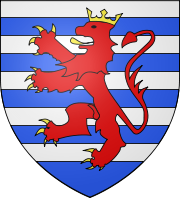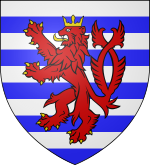William III of the Netherlands
|
||||||||||||||||||||||||||||||||||||||||||||||||||||||
|
||||||||||||||||||||||||||||||||||||||||||||||||||||||
William III (Willem Alexander Paul Frederik Lodewijk, anglicised: William Alexander Paul Frederick Louis) (19 February 1817 – 23 November 1890) was from 1849 King of the Netherlands and Grand Duke of Luxembourg until his death and the Duke of Limburg until the abolition of the Duchy in 1866.
Contents |
Early life
William was born in Brussels as son of William II of the Netherlands and Queen Anna Paulowna, daughter of Tsar Paul I of all the Russias and Empress Maria Fyodorovna (Sophie Dorothea of Württemberg). In his early years, he served in the military.
He married his first cousin, Sophie, daughter of King William I of Württemberg and Grand Duchess Catherine Pavlovna of Russia, in Stuttgart on 18 June 1839. This marriage was unhappy and was characterized by struggles about their children. Sophie was a liberal intellectual, hating everything leaning toward dictatorship, such as the army. William was simpler, more conservative, and loved the military. He prohibited intellectual exercise at home, for which action Queen Victoria of the United Kingdom, who corresponded with Sophie, called him an uneducated farmer. (His extramarital enthusiasms, however, led the New York Times to call him "the greatest debauchee of the age".) Another cause of marital tension (and later political tension) was his capriciousness; he could rage against someone one day, and be extremely polite the next.
William loathed the 1848 constitutional changes initiated by his father (William II) and Johan Rudolf Thorbecke. William II and Sophie saw them as key to the monarchy's survival in changing times. William himself saw them as useless limitations of royal power, and wished to govern like his grandfather, William I.
He tried to relinquish his right to the throne to his younger brother Henry. His mother convinced him to cancel this action. One year later (1849) William became King upon the death of his father.
Reign
King William III repeatedly contemplated abdicating as soon as his eldest son William, Prince of Orange turned eighteen. This occurred in 1858, but as William was uncomfortable making a decision he remained King. His first act was the inauguration of the parliamentary cabinet of Thorbecke, the liberal designer of the 1848 constitution, whom William loathed.

When the Roman Catholic hierarchy of bishops was restored in 1853 he found a reason to dismiss his rival. In the first two decades of his reign, he dismissed several cabinets and disbanded the States-General several times, installing royal cabinets which ruled briefly as there was no support in elected parliament.
In 1856, William unilaterally instituted a new, reactionary constitution for Luxembourg in what has become known as the 'Coup of 1856'.[1] He tried to sell the grand duchy in 1867, leading to the Luxembourg Crisis, which almost precipitated war between Prussia and France. However, the subsequent Second Treaty of London reestablished Luxembourg as a fully independent country.
The King was popular with the ordinary people, presenting himself as a cordial man.
He was the 963rd Knight of the Order of the Golden Fleece in Spain in 1842, the 777th Knight of the Order of the Garter in 1882 and the 72nd Grand Cross of the Order of the Tower and Sword.
In 1877, Queen Sophie died and years of war in the palace came to an end. In the same year, King William announced his intention to marry Eleonore d'Ambre, a French opera singer, whom he ennobled as countess d'Ambroise – without government consent. Under pressure from the government, he abandoned his marriage plans.[2][3] In 1879, King William decided to marry Princess Emma of Waldeck and Pyrmont, a small German principality. Some politicians were quite angry, as she was 41 years the king's junior. Emma showed herself, however, as a cordial woman; and when William asked permission from parliament, this was easily granted and the couple were quickly married in Arolsen on 7 January 1879. She was not his first choice. He had previously been rejected by her sister, Princess Pauline of Waldeck and Pyrmont, as well as Princess Thyra of Denmark.
Emma had a relieving influence on William's capricious personality and the marriage was extremely happy. The last decade was without any doubt the best of his reign. In 1880, Wilhelmina was born. She became heiress in 1884 after the death of the last remaining son from William's first marriage. Many potential heirs had died between 1878 and 1884.
King William became seriously ill in 1887. However in 1888, he managed to personally hand over a gold medal of honour to naval hero Dorus Rijkers for saving the lives of 20 people.
He died in Het Loo in 1890. Because Wilhelmina had not yet reached adulthood, Emma became regent for her daughter. She would remain regent until Wilhelmina's eighteenth birthday in 1898. Because the Grand Duchy of Luxembourg could only be inherited through the male line at the time, under Salic law, it went to Adolphe, the former Duke of Nassau.
Children
Of William III's children, only three reached adulthood, two sons from his marriage to Queen Sophie and one daughter from his marriage to Queen Emma:
- Willem Nicolaas Alexander Frederik Karel Hendrik (1840–1879). Heir to the Throne from 1849 till his death.
- Willem Frederik Maurits Alexander Hendrik Karel (1843–1850).
- Willem Alexander Karel Hendrik Frederik (1851–1884). Heir to the Throne from 1879 till his death.
- Wilhelmina Helena Pauline Maria (1880–1962). Queen of the Netherlands from 1890 to 1948.
Titles
- His Royal Highness Prince William of the Netherlands, Prince of Orange-Nassau (1817-1840)
- His Royal Highness William, Prince of Orange, Prince of the Netherlands, Prince of Orange-Nassau (1840–1849)
- His Majesty William III, King of the Netherlands, Grand Duke of Luxembourg, Duke of Limburg (1849–1890)
Ancestry
|
|
|
|
|
|
|
|
|
|
|
|
|
|
|
|
|
|
|
|
16. William IV, Prince of Orange | |||||||||||||||
|
|
||||||||||||||||
|
|
|
|
|
|
||||||||||||
|
|
8. William V, Prince of Orange |
|
||||||||||||||
|
|
||||||||||||||||
|
|
|
|
|
|
|
|
|
|||||||||
|
|
17. Anne, Princess Royal | |||||||||||||||
|
|
||||||||||||||||
|
|
|
|
|
|
||||||||||||
|
|
4. William I of the Netherlands |
|
||||||||||||||
|
|
||||||||||||||||
|
|
|
|
|
|
|
|
|
|
|
|
||||||
|
|
18. Prince Augustus William of Prussia | |||||||||||||||
|
|
||||||||||||||||
|
|
|
|
|
|
||||||||||||
|
|
9. Wilhelmina of Prussia |
|
||||||||||||||
|
|
||||||||||||||||
|
|
|
|
|
|
|
|
|
|||||||||
|
|
19. Louise Amalie of Brunswick-Lüneburg | |||||||||||||||
|
|
||||||||||||||||
|
|
|
|
|
|
||||||||||||
|
|
2. William II of the Netherlands |
|
||||||||||||||
|
|
||||||||||||||||
|
|
|
|
|
|
|
|
|
|
|
|
|
|
|
|||
|
|
20. Prince Augustus William of Prussia (= 18) | |||||||||||||||
|
|
||||||||||||||||
|
|
|
|
|
|
||||||||||||
|
|
10. Frederick William II of Prussia |
|
||||||||||||||
|
|
||||||||||||||||
|
|
|
|
|
|
|
|
|
|||||||||
|
|
21. Louise Amalie of Brunswick-Lüneburg (= 19) | |||||||||||||||
|
|
||||||||||||||||
|
|
|
|
|
|
||||||||||||
|
|
5. Wilhelmine of Prussia |
|
||||||||||||||
|
|
||||||||||||||||
|
|
|
|
|
|
|
|
|
|
|
|
||||||
|
|
22. Louis IX, Landgrave of Hesse-Darmstadt | |||||||||||||||
|
|
||||||||||||||||
|
|
|
|
|
|
||||||||||||
|
|
11. Frederika Louisa of Hesse-Darmstadt |
|
||||||||||||||
|
|
||||||||||||||||
|
|
|
|
|
|
|
|
|
|||||||||
|
|
23. Caroline of Zweibrücken | |||||||||||||||
|
|
||||||||||||||||
|
|
|
|
|
|
||||||||||||
|
|
1. William III of the Netherlands |
|
||||||||||||||
|
|
||||||||||||||||
|
|
|
|
|
|
|
|
|
|
|
|
|
|
|
|
|
|
|
|
24. Charles Frederick, Duke of Holstein-Gottorp | |||||||||||||||
|
|
||||||||||||||||
|
|
|
|
|
|
||||||||||||
|
|
12. Peter III of Russia |
|
||||||||||||||
|
|
||||||||||||||||
|
|
|
|
|
|
|
|
|
|||||||||
|
|
25. Anna Petrovna of Russia | |||||||||||||||
|
|
||||||||||||||||
|
|
|
|
|
|
||||||||||||
|
|
6. Paul I of Russia |
|
||||||||||||||
|
|
||||||||||||||||
|
|
|
|
|
|
|
|
|
|
|
|
||||||
|
|
26. Christian August, Prince of Anhalt-Zerbst | |||||||||||||||
|
|
||||||||||||||||
|
|
|
|
|
|
||||||||||||
|
|
13. Catherine II of Russia |
|
||||||||||||||
|
|
||||||||||||||||
|
|
|
|
|
|
|
|
|
|||||||||
|
|
27. Johanna Elisabeth of Holstein-Gottorp | |||||||||||||||
|
|
||||||||||||||||
|
|
|
|
|
|
||||||||||||
|
|
3. Anna Pavlovna of Russia |
|
||||||||||||||
|
|
||||||||||||||||
|
|
|
|
|
|
|
|
|
|
|
|
|
|
|
|||
|
|
28. Karl Alexander, Duke of Württemberg | |||||||||||||||
|
|
||||||||||||||||
|
|
|
|
|
|
||||||||||||
|
|
14. Frederick II Eugene, Duke of Württemberg |
|
||||||||||||||
|
|
||||||||||||||||
|
|
|
|
|
|
|
|
|
|||||||||
|
|
29. Princess Maria Augusta of Thurn and Taxis | |||||||||||||||
|
|
||||||||||||||||
|
|
|
|
|
|
||||||||||||
|
|
7. Sophie Dorothea of Württemberg |
|
||||||||||||||
|
|
||||||||||||||||
|
|
|
|
|
|
|
|
|
|
|
|
||||||
|
|
30. Margrave Frederick William of Brandenburg-Schwedt | |||||||||||||||
|
|
||||||||||||||||
|
|
|
|
|
|
||||||||||||
|
|
15. Friederike Dorothea of Brandenburg-Schwedt |
|
||||||||||||||
|
|
||||||||||||||||
|
|
|
|
|
|
|
|
|
|||||||||
|
|
31. Princess Sophia Dorothea of Prussia | |||||||||||||||
|
|
||||||||||||||||
|
|
|
|
|
|
||||||||||||
See also
- Dutch monarchs family tree
Notes and references
- ↑ (French) "Proposition de revision portant modification et nouvel ordonnancement de la constitution du Luxembourg". Council of Europe. 26 August 2009. http://www.forum.lu/pdf/artikel/5921_261_Huberty.pdf. Retrieved 6 December 2009.
- ↑ G.A.M. Beekelaar (1989) (in Dutch), Heeckeren tot Kell, Willem baron van (1815–1914), Instituut voor Nederlandse Geschiedenis, http://www.inghist.nl/Onderzoek/Projecten/BWN/lemmata/bwn3/heeckeren, retrieved 2009-08-31
- ↑ van den Bergh, H.; Vinken, P.J. (2002) (in Dutch), Klein republikeins handboek: honderd misverstanden over de monarchie, Uitgeverij Boom, pp. 58–59, ISBN 9053527346
External links
- Royal House of the Netherlands and Grand-Ducal House of Luxembourg
- Royal House of Württemberg
- Princely House of Waldeck and Pyrmont
| Willem III van Oranje-Nassau (1817-1890) on Familypedia |
|
William III of the Netherlands
Born: 17 February 1817 Died: 23 November 1890 |
||
| Regnal titles | ||
|---|---|---|
| Preceded by William II |
King of the Netherlands 1849–1890 |
Succeeded by Wilhelmina |
| Grand Duke of Luxembourg 1849–1890 |
Succeeded by Adolphe |
|
| Duke of Limburg 1849–1866 |
Duchy Abolished Treaty of London (1867)
|
|
| Dutch royalty | ||
| Preceded by William, Prince of Orange later became King William II |
Prince of Orange 1840–1849 |
Succeeded by William, Prince of Orange |
| Heir to the Dutch throne as heir apparent 1840–1849 |
||
|
|||||
|
||||||||||||||||||||||||||||||||||||||||||||||||||||||||||||||||||||
|
|||||||||||||||||||||||
.jpg)



